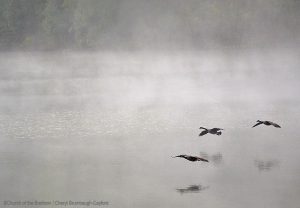
“Jesus used stories when he spoke to the people. In fact, he did not tell them anything without using stories. So God’s promise came true, just as the prophet had said, ‘I will use stories to speak my message and to explain things that have been hidden since the creation of the world’”
(Matthew 13:34-35, CEV).
A REVIEW OF NOAC 2015
1) Deanna Brown focuses first NOAC keynote on women’s stories
2) Brian McLaren calls NOAC to get back to the Bible, in a different way
3) Bob Bowman’s Bible studies focus on Prodigal Son parable
4) Dialogue urges Christians to work intentionally across racial divides
5) Chief Junaluska of the Cherokees: A story from the NOAC Coffeehouse
6) ‘You’re the bear, Kim’: An interview with Dub, the NOAC bear
7) NOAC by the numbers
8) ‘Today at NOAC’ pages, photo albums offer daily view of the conference
9) Brethren bits: A focus on the refugee and migrant crisis, plus news of Children’s Disaster Services response to California wildfires, Sept. 20 Mission Offering, 39th Brethren Disaster Relief Auction, personnel notes, job openings, prayer requests, March for Peace in Haiti, more.
Quotes of the week:
“The honking wild goose intrudes upon us as the image of the Holy Spirit, coming upon us across the seas and waters.”
— Deanna Brown, one of the keynote speakers at NOAC 2015, wondering aloud about why the Celtic Christian tradition chose for its symbol of the Holy Spirit the wild goose–which she described as loud, messy, and disruptive–in place of the quiet cooing dove. Wild geese were to be seen every day at the National Older Adult Conference held around Lake Junaluska in western North Carolina, from Sept. 7-11.
“Today the countries of Europe are confronted with the worst refugee crisis since the Second World War. But compassion and action seem to be tragically insufficient to meet the pressing need…. Today, Europe–both West and East–is being tested on the strength of its commitment to human dignity and rights. This is a test of our human values and Christian legacy.”
— From a World Council of Churches (WCC) statement about the refugee and migrant crisis. In a follow up release, general secretary Olav Fykse Tveit stressed that it is “absolutely and critically necessary that all European states take their proper responsibility in terms of reception and support for people seeking refuge, safety, and a better future for themselves and their families.”
“The primary truth of faith as we consider…refugees today is that Christ has made another appearance among us, as Himself a…refugee in the person of political dissidents, the economically deprived, and foreigners on the run. We are to join them as pilgrims in search of that city yet to come, with foundations of love and justice whose architect and builder is God.”
— From a statement of the Church of the Brethren Annual Conference of 1982. Find the full statement at www.brethren.org/ac/statements/1982refugees.html .
******************************************************
Coverage of the 2015 National Older Adult Conference of the Church of the Brethren was carried out by the NOAC Communication Team: writer Frank Ramirez, photographer and media guru Eddie H. Edmonds, web staff Russ Otto, and photographer and editor Cheryl Brumbaugh-Cayford, director of News Services for the Church of the Brethren.
Go to www.brethren.org/news/2015/noac.html for the news index page from NOAC 2015 featuring links to web pages, photo albums, the NOAC Notes, worship bulletins, and even a sample video clip from the notorious (and hilarious) NOAC News crew.
******************************************************
1) Deanna Brown focuses first NOAC keynote on women’s stories
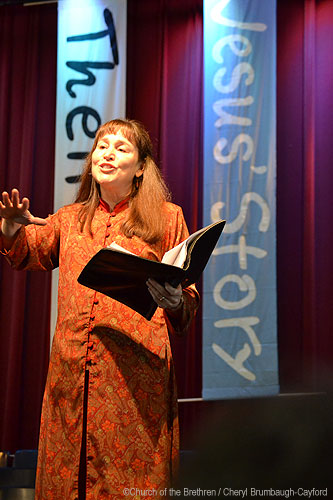
Deanna Brown focuses on women’s stories in her keynote address to NOAC 2015.
Why would the Celtic Christian church choose the image of a wild goose for the Holy Spirit instead of a dove?
Deanna Brown began her keynote address at NOAC by telling the story of a peaceful setting. During the wee hours of May 24, 2014, she sat wrapped in silence and in a shawl by the shores of Lake Junaluska, eyes to the sky as she waited for the best view of a new meteor shower.
Then the peace was shattered “by the old piercing clamor of wild geese.” For long, long minutes their honking shattered the “sweet wonder” Deanna was waiting for. Memories of that moment have led her to ask why some have chosen the wild, honking, disruptive goose as a symbol for the Holy Spirit.
The stories of Jesus, she said, demonstrate the disruptive action of God’s Spirit, an overturning of the status quo which may be necessary for transformation. “The reign of Jesus is not just a continuation of the status quo,” she said. “Jesus used these stories to subvert conventional wisdom…a shattering of habitual thinking.”
Stories are powerful, she reminded the NOAC audience. “Centuries later we remember those [Jesus’] stories, not just theological propositions.” She challenged her listeners to “listen to the wild, honking spirit that is calling across the waters.”
Moving on to tell contemporary stories from her work to connect American women with women in India and Turkey, she told about harrowing journeys by bus and train in India. In one bus, so full of people it would first lean right, then left, she had thankfully found an empty seat when an Indian woman plopped her baby in Deanna’s lap. It was symbolic of that culture’s “we are all in this together” attitude. In the train in India, she said, you can’t tell where one family begins and ends in part because the people all share their food together.
These real life experiences help American women both connect with Indian women, and also critique their own society here in the United States. Brown’s organization Cultural Connections, opens eyes and hearts across the cultural divides and leads to greater advocacy on the issues of importance to women including domestic violence, sexual trafficking, the education of girls, and more.
Similarly, two stories told by Brethren leaders who traveled to a devastated and starving Europe on the heels of World War II helped transform the church in the years that followed. One experience was told by a Brethren relief worker who was riding in a jeep with American soldiers, and they passed by the body of a dead child on the side of the road and the mother bewailing her infant, and the soldiers took no notice. In the other story, a German woman in Berlin told a Brethren visitor that she was going to have to choose which of her four children were most likely to survive the winter, in order to give that child the little food she could scrounge, leaving the other children to die. These two stories led to an outpouring of giving from the Church of the Brethren at that time, which Brown asserted mere facts and statistics could not inspire.
Her presentation concluded with two short films from the Girl Rising project, about the lives of girls in Ethiopia and Afghanistan, the horrors they endure, and their will to prevail. The stories of these girls, along with information about how the education of girls and women may be the most effective way the world can work at ending poverty and hunger, left many in tears in the congregation.
She told one final, personal story, about her mother’s several failed pregnancies and the congregation in Iowa that nurtured her parents through those grievous experiences, and whose outpouring of caring eventually led to her own successful birth. This family story, which she heard repeated over and over again, is now ingrained in her life, she said. It is what keeps her connected to the Church of the Brethren despite frequent frustrations about structural obstacles in the church. “I owe my life to a little Church of the Brethren congregation that worked together to birth new life.”
2) Brian McLaren calls NOAC to get back to the Bible, in a different way
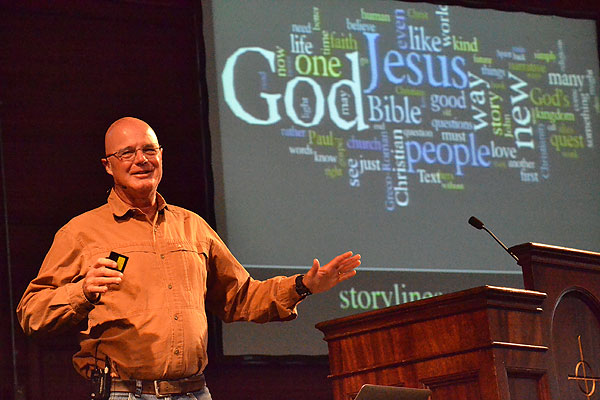
Brian McLaren speaks at NOAC 2015
“I can tell you love each other,” Brian McLaren said to the NOAC congregation as he began his morning keynote address. McLaren is a popular author, speaker, activist, and public theologian. His two most recent books are “Why Did Jesus, Moses, the Buddha, and Mohammed Cross the Road? Christian Identity in a Multi-Faith World” and “We Make the Road By Walking.”
For most American Christians, getting back to the Bible means a “backwards” view of the text, McLaren told the NOAC audience. Usually we transmit and interpret the Bible via all the theologians and scholars and church leaders who have left their marks on the history of the faith, as well as the popular writers who dominate Christian bookstores today. The problem, he said, is that means most of us try to squeeze scripture into a matrix that is human-devised rather than biblical.
Instead, McLaren suggested that the best way to go forward in faith as a Christian is to work at getting back to the Bible’s original understanding, not the one we have developed over the centuries since.
That does not mean McLaren ignores the rich history of landmark theologians. During the course of his talke he quoted Martin Luther, as well as Father Vincent and Vaclav Havel and many others who have provided biblical interpretations. But he centered his attention on the core narrative of the Bible found in Exodus, Genesis, and Isaiah, which is about God’s history, not ours.
McLaren repeatedly displayed a graph that he had developed earlier in his ministry, when he tried to squeeze every Bible narrative, as well as other historical narratives, into the same flow chart. In this chart, the path from Eden to Heaven is sideswiped by the Fall, where a choice is made to accept the offer of salvation leading back to heaven, or the choice of denial that leads to Hell. This is the narrative flow of the typical American Christian understanding, he said.
By contrast, the core biblical storyline is in three parts: the central narrative of Exodus, a story of liberation and formation; the “prequel” in Genesis, which is about Creation and reconciliation; and the “sequel” in Isaiah, about how to seek a peaceable kingdom of justice and mercy.
“This is not an elevator theology,” McLaren said. “This is an incarnational theology,” based on the interaction between real people and God, and people with each other.
Christians, he said, “should learn and tell a better story of justice, peace, and joy,” and not parrot flawed and outdated storylines. God’s people are called to tell an alternate story that can be shared in common with all people. “Link your story with God’s story.”
3) Bob Bowman’s Bible studies focus on Prodigal Son parable
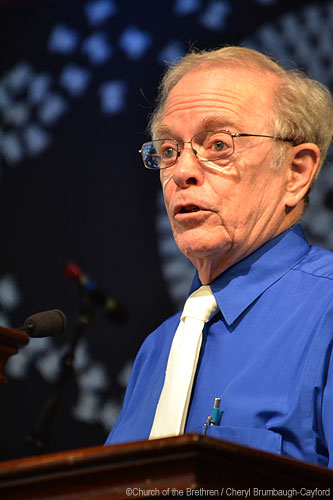
Bob Bowman leads Bible study at NOAC 201
“You’ve probably taught this parable yourself…but its my turn this time,” said Bob Bowman, introducing the first of his three daily Bible studies at NOAC, focused on Jesus’ parable of the Prodigal Son from Luke 15.
In presentations that were part stand-up, part biblical scholarship, and all relevant to life today, Bowman focused each day in turn on one of the three main characters in the parable: the Older Brother, the Prodigal younger brother, and the Father.
He suggested that “words in a parable are pared down to their essentials,” and that Jesus may have used parables in a number of different ways, as “a subtle criticism of his own culture,” or to “drive home an important point,” or to relate a verbal problem almost like a Zen koan for his disciples to meditate on and lead them to new insights or an aha moment.
The Older Brother
One reason Bowman said the Older Brother is crucial to discovering the meaning of the parable is, perhaps counter intuitively, the Older Brother is not really necessary to the basic plot of the story. If the Prodigal younger brother wasted all the money, repented, and was forgiven, without the response of the Older Brother, the parable would still end in joy. “It ends fine without (the Older Brother),” so his inclusion must be crucial said Bowman.
Bowman, an older brother himself, characterized the NOAC congregation as “older brothers” too–in terms of their role in the church and in society, taking responsibility, keeping things going, doing the hard work required to support a family, providing stability.
But in many folk tales and in other Bible stories, particularly the Old Testament, the younger brother usurps the older brother. For example, Isaac is picked over Ishmael; David is anointed to be king in place of his older brothers; Joseph is triumphant despite his older brothers’ plans to eliminate him. “Younger brothers successfully pull the rug out from under the feet of older brothers,” Bowman said.
He characterized this basic plot line as a story based on “empire” as opposed to the reign of God or the Kingdom of God, in which “there’s room enough for everyone to win without someone having to lose.”
The Older Brother’s ultimate response to the return of his Prodigal and profligate younger brother is left open by Jesus. Thus the story is open ended, Bowman said, and Jesus allowed his hearers to decide the ending for themselves.
Bowman pondered aloud how he would end the story, as an older brother himself: after hearing that his younger Prodigal brother had returned and was welcomed back by his father with open arms, and getting angry about it, perhaps the Older Brother would say he just needed a few minutes to get used to the new situation, and would soon be able to join the party.
“Because that’s what we ‘older brothers’ do.”
The Prodigal
In Bowman’s Bible study, Part II, he began by noting that Jesus’ parables hold more than one meaning, but the interpretation must fit the text. Today’s parable, he said, is not yesterday’s parable because today we are not the same people we were yesterday.
He also had disappointing news for everyone who had come out to hear him speak on the topic “A Certain Woman Had Two Daughters,” which had been announced as the topic for the day’s study. He had given that title to the NOAC planning team six months previously, but had found in the time since that it didn’t work! No one seemed to mind as Bob mined Luke 15:11-32 for more gold.
He surprised more than a few listeners when he pointed out that it is the Older Brother, not the parable itself, that suggests the Prodigal younger misspent his share of the inheritance on wine, women, and song. “Maybe the women are part of the older brother’s imagination,” he said. The original Greek text states that the Prodigal lost the money in “self-destructive living.”
Bowman asked his listeners to imagine that the Prodigal was part of the Diaspora of God’s people, the scattering of the Jews throughout the Persian and Roman Empires–he might have sought his destiny in the wider world with his father’s blessing.
Whatever happened, the money was soon gone and the younger brother experienced not repentance, or a turning away, but conversion, a turning towards. Whatever he had been attempting to do had failed. In leaving, he discovered who he really was, and had determined to come home.
Bowman reviewed other Bible stories, such as that of Joseph and his brothers, about people who take great risks to become part of the Father’s blessing–and the different roles of the older and younger siblings in such stories. These stories demonstrate that “parental love is never equally distributed,” Bowman said, and the older and younger siblings must come to terms with that truth.
The Older Brother, “teetering on the edge of his dilemma, of unequally distributed love in the world,” has an important choice to make. He had never learned the lessons of failure that led to the younger, Prodigal brother’s rediscovery of true identity. So Bob dramatized several possible endings to the story, in some of which the Older Brother’s choice leads to joy in the family.
The Father
While demonstrating there are many ways interpret a parable like the Prodigal Son, Bowman suggested in his third session of Bible study that the use of allegory–in which each character and item in a story stands for something else–can be disappointing. “Allegory tends to flatten the story. Allegory tends to stereotype people.”
For instance, insisting that the Older Brother stands for the Pharisees breaks down pretty quickly, he said. “Any true Pharisee would rejoice at a repentant sinner!” As for the suggestion made by some that Jesus is the fatted calf, sacrificed to save the family, Bob only shook his head.
What can be helpful instead, he said, is to put ourselves in the place of each of the characters. “It’s important to experience what each person went through. I want to hover over the figure of the Father,” Bowman said.
In many ways what the Father does in the parable–giving the younger son his inheritance and going out to meet the older brother, rather than insisting the older brother come in the house to see him–is neither dignified nor honorable in a society where saving face is integral. This is part of the “unreasonable extravagance” of the Father.
“Can you think deep down in your bones and identify with a parent who asked nothing of you…whose love was so great for you he threw a party? …The father is more interested in having both sons home that in receiving repentance,” Bob asserted, and then asked, “Is the center post of our faith sin and forgiveness, or is the center post of our faith a relationship with God, each other, and a suffering humanity?”
Surprises abound in the story. Unlike other parables in which the shepherd goes out looking for the lost sheep and the woman seeks her lost coin, “no one goes out looking for the Prodigal. However, the Father went out to seek the Older Brother,” Bowman pointed out. And in pleading with the Older Brother, “the Father did not defend the prodigal. He only defended his joy.”
4) Dialogue urges Christians to work intentionally across racial divides
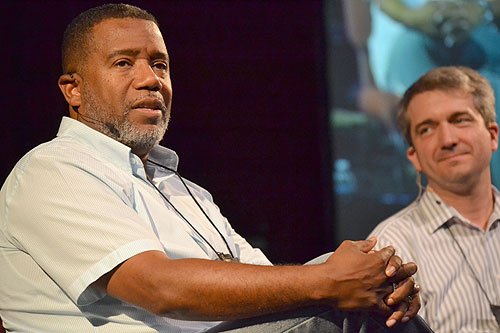
Alexander Gee Jr. (left) and Jonathan Shively offer a dialogue on the need to intentionally develop relationships across racial divides in the Christian community
A lot of well meaning people assume that the Civil Rights struggle is over and that we won, said Alexander Gee Jr., during an afternoon dialogue event at NOAC 2015. “We don’t talk about it in seminary, in churches, or from the pulpit,” he said. “Like polio or tuberculosis, we say we’ve solved it!”
However, Gee warned the NOAC audience of older adults: “You’re the generation that watched the Civil Rights struggle, but for your children and your grandchildren this is ancient history. Honor your legacy.”
Gee, who hails from Madison, Wis., is founder and president of the Nehemiah Urban Leadership Institute and senior pastor and founder of Fountain of Life Family Worship Center, and the leading Black clergy in Madison. But in the wake of a series of murders involving young black men, he wrote an op-ed piece for a Madison newspaper that attracted national attention and a firestorm of controversy.
He suggested, out of bitter personal experience of incidents with local police, that much work remained to be done in the Civil Rights struggle. “We thought we solved that in the ’60s,” he said. “In my experience it’s still going on.”
In one incident, police accosted him in the parking lot of his own church. “They told me I fit the profile of a drug dealer,” he said, when he was pulled over for wearing a nice suit and driving a good car. Such personal experiences, he said, illustrate the discrepancies in life experience between white and Black.
“When I was growing up they told me to go to university, get a job, and keep my nose clean,” he said. But all of a person’s achievements in education, experience, reputation, and status in the community goes out the window in a society where skin color affects every interaction, particularly with law enforcement.
Dr. Gee appeared on the NOAC stage with Jonathan Shively, executive director of Congregational Life Ministries for the Church of the Brethren. The two became close friends after participating in a program that intentionally pairs individuals for a cross-cultural experience of visiting site iconic to the Civil Rights movement.
He praised the NOAC audience for having been participants in the Civil Rights struggles of the ’50s and ’60s. He said that when he was criticized nationally for suggesting that a model community like Madison might be “Ground Zero of racial inequities,” it was individuals in their 70s and 80s who came to his support.
“We know we have not finished this fight yet.”
5) Chief Junaluska of the Cherokees: A story from the NOAC Coffeehouse
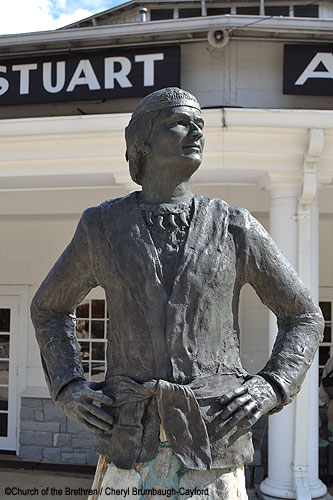
A statue of Chief Junaluska stands outside the Stuart Auditorium at Lake Junaluska Conference Center
This is one of the stories shared at the NOAC Coffeehouse, submitted by Willard “Duly” Dulabaum:
Chief Junaluska was born around 1775 in North Carolina, near present day Dillard, Ga. A few days after his birth, he was given his original name when the cradle-board holding him fell over. He was called “Gu-Ka-Las-Ki” or” Gulkalaski” in the Cherokee language, meaning “one who falls from a leaning position” (1). A couple more revisions to his name followed into adulthood. He married Ni-suh, and had three children, boys Jim-my and Sic-que-yuh, and daughter Na-lih. He became a leader of the Eastern Band of Cherokee Indians residing in and around western North Carolina. He would go on to fight alongside Andrew Jackson and save his life at the Battle of Horseshoe Bend, a so-called “unsung hero of the greatest Indian battle in history” (2).
At one point, Chief Junaluska reportedly had sent word to Tecumseh that the Cherokee would not join an Indian confederacy against the whites. So when the Creek Indians in Alabama fought with the British in the War of 1812, the Cherokee raised an army to oppose them. Chief Junaluska personally recruited over 100 men for the Battle of Horseshoe Bend, and commanded 500 (2). Further, he assumed strategic leadership to help secure the decisive and famous victory near the end of the war. It was there that he tripped a prisoner of war who was lunging at Jackson with a knife.
When the Battle of Horseshoe Bend was over, Andrew Jackson was reported to have told Chief Junaluska: “As long as the sun shines and the grass grows, there shall be friendship between us, and the feet of the Cherokee shall be toward the east” (1, 2). But in a few years, Jackson was in the White House and set about to remove all the Cherokee to new homes in the West, in what would be called the Great Removal. At that point, Chief Junaluska was said to have second thoughts about having saved Jackson’s life.
During the infamous “Trail of Tears” in 1838, Chief Junaluska and others of the Cherokee Nation were incarcerated for a time, and then were among over 5,000 who were led over 800 miles in bands of 1,000 or more to land in Oklahoma, which was considered much less desirable. Chief Junaluska broke away once, leading a group of 50, but was captured. However, after a short time in what is now Oklahoma, he returned to the mountains of his birth by 1842, walking all the way! In 1847 the state legislature of North Carolina conferred upon him the right of citizenship and granted him a tract of land at what is now Robinsville. He died there in 1858 and was buried with his second wife (1) on a hill above the town where the Daughters of the American Revolution erected a monument to his memory.
A bronze plaque bolted to a great hunk of native stone replaced the earlier, traditional Cherokee pile of stones. It reads, in part: “Here lies the bodies of the Cherokee Chief, Junaluska, and Nic-ie, his wife. Together with his warriors he saved the life of General Jackson at the Battle of Horseshoe Bend, and for his bravery and faithfulness North Carolina made him a citizen and gave him land in Graham County.”
He has been memorialized by Lake Junaluska, Junaluska Creek, Junaluska Gap, Junaluska Ridge, the Junaluska Salamander, and Mount Junaluska (now known as North Eaglenest Mountain). And Brethren who attend the National Older Adult Conference gather around his statue before and after each session at the Lake Junaluska Assembly, where he appears regularly in group photographs and may even find a new future in “selfies.”
Sources: (1) Wikipedia, and (2) Georgia Tribe of Eastern Cherokee website.
— Willard “Duly” Dulabaum is an ordained minister in the Church of the Brethren, and a member at Highland Avenue Church of the Brethren in Elgin, Ill.
6) ‘You’re the bear, Kim’: An interview with Dub, the NOAC bear
Frank Ramirez of the NOAC Communication Team recently had an opportunity to interview Dub the Bear, who has been seen almost everywhere at this year’s NOAC. Dub, it appears, came specifically to NOAC this year to honor Kim Ebersole for her contributions to the Church of the Brethren through this ministry and many others. At least we think that’s what she’s telling us.
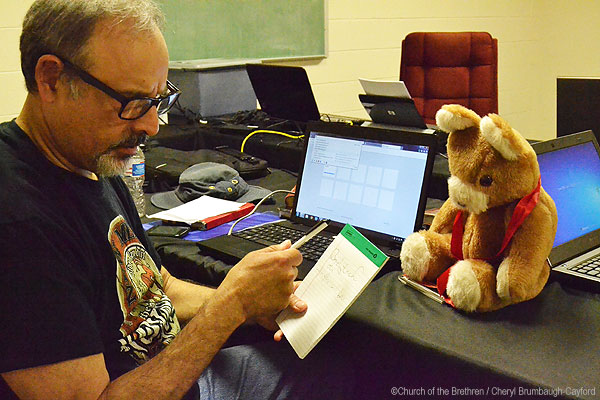
Question: Dub, you’ve been seen almost everywhere here at Lake Junaluska over the course of the week. Could you say just a little bit about what brings you here?
Dub: Daaahling, please! It’s pretty simple. It’s all about the Kim.
Q: If you could perhaps–
Dub: When you think of me, you think of Kim. When you think of Kim, you think of me. It’s pretty obvious. I’m short. I’m cute. I’m cuddly. And I’m not in the least bit tame, so you’d better watch your step when you’re around me.
Q: That sounds a little….
Dub: It’s the whole cub thing. You don’t get between a bear and her cubs, and you don’t get between Kim and all these folks at NOAC she cares so passionately about. I have to admire that kind of thing, wherever I find it, whether it’s looking in the mirror or watching just what Kim’s been doing for her “cubs,” all these folks who’ve been coming out here to my lake every two years for National Older Adult Conference.
Q: “Your” lake?
Dub: In a manner of speaking. It’s not like I took out a mortgage or anything like that.
Q: But we see geese, ducks, and a lot of roses. I don’t recall seeing a bear in all the times I’ve come here to Lake Junaluska.
Dub: Seriously? Like I’m going to walk around in broad daylight and make myself a target for one of those dart guns. They don’t really hurt, but there’s this “pfffft” and suddenly you wake up in Yellowstone or Yosemite, or one of those places out west, and I’m an east coast bear, thank you very much. But listen, I’m here to talk about the Kim. Can we get back on subject? And hurry. I mean, I have a dumpster to dive into as soon as it gets dark.
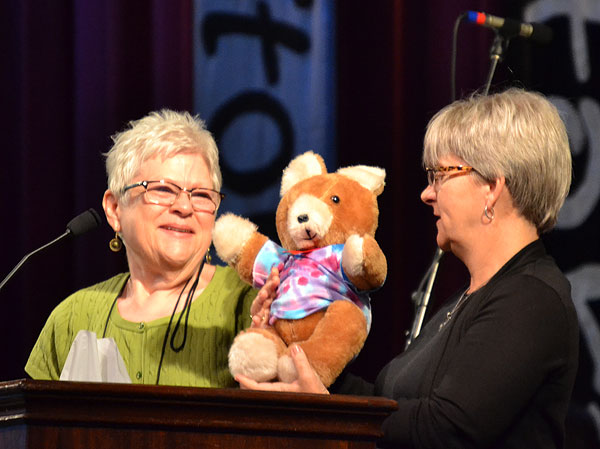
Kim Ebersole (left), who is retiring as NOAC coordinator, receives gifts from Debbie Eisenbise, who will be coordinating the next NOAC in 2017. The bear is a memento from NOACs past, when a NOAC sewing circle made stuffed toys for children. It wears a t-shirt tie dyed at this NOAC.
Q: Of course. So what do you admire most about Kim?
Dub: The way she answered the call when she was asked to take over NOAC from some pretty serious talent. Sort of reminds me of the way I have to answer the call of the wild. You know, bare my teeth, that kind of thing. And Kim is the sweetest person in the world, but she’ll do anything to make this week here at the lake a memorable one for every single person who’s ever come here.
Q: Is this related to the mother-cub thing you were talking about?
Dub: Read those notes you’re pretending to scribble there. Kim’s got one big heart, the biggest heart there is. Let me tell you something, and don’t write this down, but getting to know Kim is like finding an uneaten pizza in the trash bin–she’s the whole package.
Q: Anything else you’d like to say?
Dub: Yes. Definitely. First, that whole Bible thing, about me and my girlfriend eating 42 kids because they made fun of Elisha for being bald. EXAGGERATION! Yes, I showed a little teeth. Yes, I might have growled, but then those kids ran home, blew everything out of proportion, and the next thing you know, it’s Bible Headlines! Seriously. Maybe I could have eaten one of them, maybe two, but I’d just eaten a whole hive of honey. I’m a bear, not an eating machine.
Q: Anything else?
Dub: Yes. (Reading from a press release.) On behalf of all the animals here at Lake Junaluska I want to officially thank Kim Ebersole for all her caring and hard work. You’re the bear, Kim. You’re the bear.
— Frank Ramirez pastors Union Center Church of the Brethren in Nappanee, Ind. He is a member of the volunteer Communication Team for NOAC 2015.
7) NOAC by the numbers
The 2015 National Older Adult Conference, which was the Church of the Brethren’s 13th NOAC, gathered 906 people at the Lake Junaluska (N.C.) Conference Center on Sept. 7-11. This number includes registered participants, staff, volunteers, guest speakers, and young adult assistants.
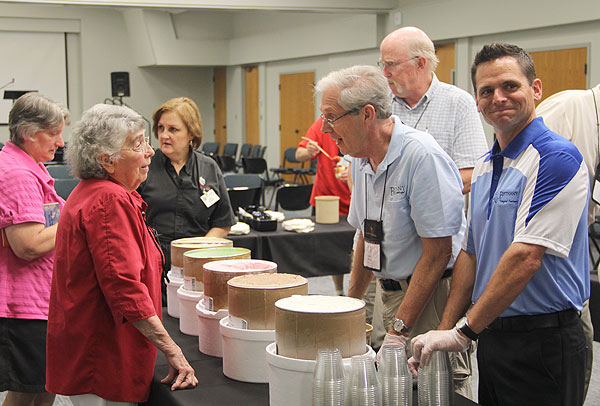
Bethany Seminary hosted one of the daily ice cream socials at NOAC
Here are some more NOAC numbers:
Offerings:
$3,297.43*: offering received during worship on Monday, Sept. 7
$8,662.02*: offering received during worship on Wednesday, Sept. 9
$11,344.19*: offering received during worship on Friday, Sept. 11
NOAC for Nigeria walk/run around Lake Junaluska:
$1,010: received in registration fees
$8,939*: received in additional donations to the Nigeria Crisis Fund
$9,949*: total raised for the Nigeria Crisis Response
Kits for Kids:
46: number of NOAC volunteers who assembled kits for distribution by Church World Service, through the Brethren Service Center in New Windsor, Md.
416: number of School Kits assembled
287: number of Hygiene Kits assembled
$1,283*: received in donations to Church World Service
Share a Story:
403: new books donated to Junaluska Elementary School–more than one each for the school’s 350 students
1 box: gently used books donated to the elementary school for classroom use
1 box: extras from the Kits for Kids service project donated to the school to aid students in need
And now…NOAC News!:
Too many to count: laughs, chuckles, contented sighs, and even the occasional tear elicited from NOACers by the video antics of the NOAC News crew: David Sollenberger, Larry Glick, and Chris Brown.
*The Treasurer’s Office notes that these are not final numbers, but represent the tally of checks and cash donations as of this publication date.
8) ‘Today at NOAC’ pages, photo albums offer daily view of the conference
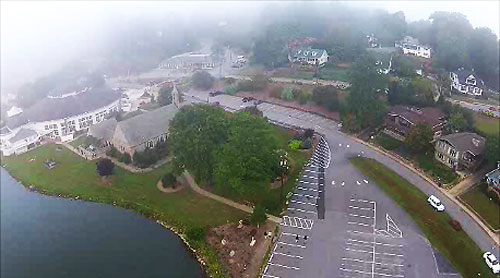
A “peace drone” view of Lake Junaluska’s Stuart Auditorium and surrounding area
The daily “Today at NOAC” webpages and online photo albums offer a view of the National Older Adult Conference as it unfolded. Each “Today” page includes a daily scripture focus based on the NOAC theme text from Matthew 13, quotes of the day, photos, reports on the day’s events, and more. The photo albums offer images from each day’s events, and more.
Find links to the photo albums at the NOAC 2015 news index page:
www.brethren.org/news/2015/noac.html
Find the “Today at NOAC” webpages at the following links:
Monday: www.brethren.org/news/2015/noac/today-at-noac-monday.html
Tuesday: www.brethren.org/news/2015/noac/today-at-noac-tuesday.html
Wednesday: www.brethren.org/news/2015/noac/today-at-noac-wednesday.html
Thursday: www.brethren.org/news/2015/noac/today-at-noac-thursday.html
Friday: www.brethren.org/news/2015/noac/today-at-noac-friday.html
9) Brethren bits: A focus on the refugee and migrant crisis
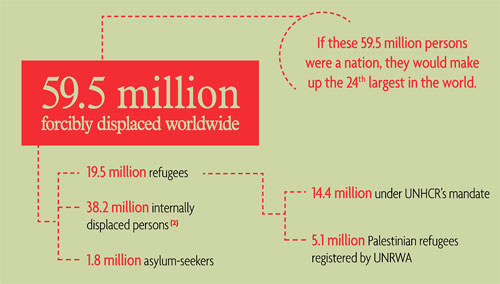
— Brethren Disaster Ministries is preparing to direct grants to support refugees from Syria, Afghanistan, and Somalia who are moving through transit nations including Serbia, Hungary, Greece, and Egypt. The grants will be from the Emergency Disaster Fund (EDF). “The situation is becoming more challenging as some countries close boarders. Most refugees are hoping to make it to northern Europe for resettlement,” said Roy Winter, associate executive director of Global Mission and Service and Brethren Disaster Ministries. In a brief interview by phone, he emphasized that the refugee and migrant crisis involves not only people displaced from Syria and Iraq, but also the displaced in Nigeria, and those forced from their homes in many other nations worldwide. More than 59.5 million people are considered displaced as of the end of 2014–the most ever in recorded history, according to a recently published report from the UNHCR, the United Nations refugee agency. “Heartbreaking” is the word Winter used as he added that half of the displaced are children. Brethren should remember that the current EDF grants build upon some years of work on the Syria crisis by Church of the Brethren staff, including the attendance of general secretary Stan Noffsinger at several international ecumenical meetings held under the auspices of the World Council of Churches–at which he was one of just a few representatives from American churches. “We can’t divert our attention from the root causes,” Winter said, noting the groundwork that Brethren and others have helped lay for an ecumenical Christian aid effort now ongoing in Europe. His suggestions for concerned Brethren include: praying, giving to the Emergency Disaster Fund at www.brethren.org/edf to support the international ecumenical response aiding refugees and migrants, contacting a Church World Service office to sponsor a refugee (see www.cwsglobal.org/refugee ), and supporting displaced Nigerians by giving to the Nigeria Crisis Fund at www.brethren.org/nigeriacrisis . — An Action Alert from the Church of the Brethren Office of Public Witness calls Brethren to join other Christians in urging the US government to accept more refugees who are fleeing the conflict in Syria as well as from other nations. Citing a statement of the 1982 Church of the Brethren Annual Conference, the alert says, in part: “The Church of the Brethren has long supported refugees displaced from their homeland. In the past, we called for the Federal government ‘to support and harbor refugees from war, oppression, famine, and natural disasters… We also favor generous temporary care for refugees who, upon fleeing their homeland, find their first asylum in the United States. As we grapple with increasingly heartbreaking and tragic reports of Syrian refugees dying as they seek safety in the region and in Europe, it is clear that the Church of the Brethren must pressure the United States to respond with leadership. The fact that the US has only resettled 1,517 Syrian refugees since the beginning of the conflict is inexcusable. While resettlement is not the only solution, it is a critical way the US can support countries like Lebanon, Turkey and Jordan that are hosting millions of Syrian refugees. The United States can and should resettle at least 100,000 Syrian refugees this coming fiscal year, in addition to increasing our total resettlement commitment from 70,000 to 100,000 refugees from all parts of the world.” The alert offers a number of actions that Brethren may choose to take, such as signing an online petition, calling the White House, and sharing the concern via social media. Find the full Action Alert at http://cob.convio.net/site/MessageViewer?em_id=34421.0&dlv_id=42721 . — Among other organizations calling for action on the refugee and migrant crisis is the National Council of Churches (NCC) which has joined in calls for the US to open its borders to 100,000 Syrian refugees this coming fiscal year, in addition to increasing the total US resettlement commitment to 100,000 refugees from other parts of the world. “Along with our ecumenical colleagues in the World Council of Churches, the Conference of European Churches, and the Churches’ Commission for Migrants in Europe, we also call upon the European Union to put in place policies which enable safe and legal pathways into Europe including issuing of humanitarian visas, lifting of visa requirements for persons fleeing from conflict zones, easier and more generous family reunification for persons in need of or granted international protection, and humanitarian admission,” said a statement from the NCC. The statement calls the United Nations and member states to commit their diplomatic and humanitarian agencies to bring about an end to the crisis. “From the very beginning, the Church has identified itself with refugees,” the NCC statement said, in part. “Our ancestors in faith were themselves refugees when they fled the chariots of Pharaoh after escaping from slavery. Jesus himself was a refugee when his family fled to Egypt to escape the sword of Herod. Whenever early Christians were persecuted, they were made refugees…. Today, fellow Christians and their Muslim neighbors are fleeing violence in Afghanistan, Eritrea, Iraq, Somalia, and Syria in numbers not seen since 16 million people were forced from their lands during the Second World War. And worse, this current refugee crisis is growing…. We call upon all people of conscience to join with churches and other organizations in compassionate responses to this crisis.” Find the full statement at http://nationalcouncilofchurches.us/news/2015-9_Syria_Refugees.php . — European churches and ecumenical organizations have marshaled resources to support and welcome those seeking safety from war and conflict, according to a World Council of Churches (WCC) release. “According to the United Nations refugee agency (UNHCR), more than 300,000 refugees and migrants have traversed the dangerous sea route across the Mediterranean this year, with more than 200,000 landing in Greece and a further 110,000 in Italy,” the release said. “The year-to-date statistics from the UNHCR represent a large increase from last year, when around 219,000 people crossed the Mediterranean.” ACT Alliance, which is a partner organization of the WCC, is providing life-saving humanitarian aid in the countries of origin of refugees, including Syria and Iraq; in neighboring countries including Turkey and Lebanon; and increasingly in transit countries including Greece, Serbia, and Hungary, according to the release. “Churches’ Commission for Migrants in Europe with its members across Europe is engaged in monitoring the situation, advocacy among churches and European institutions, awareness raising and legal counselling with a focus on family reunification, especially with its project Safe Passage.” Others actively involved with the refugee crisis in Europe include the World Communion of Reformed Churches, Lutheran World Federation, Conference of European Churches, Evangelical Church in Germany, the Reformed Church and the Lutheran Church in Hungary and Hungarian Interchurch Aid, WCC member churches in Greece as well as the Ecumenical Refugee Program of the Church of Greece. Find an ACT Alliance statement on the refugee crisis at http://actalliance.org/press-releases/act-alliance-calls-for-a-collective-and-rights-based-response-from-eu-member-states-to-the-refugee-crisis . The WCC statement on refugees is at www.oikoumene.org/en/resources/documents/general-secretary/statements/statement-on-refugees-in-europe . — The world’s refugee and migrant crisis, by the numbers: 16 million: the number of people who were forced from their lands during World War II, to put the current crisis in historical perspective (source: NCC). 11,597,748: People from Syria who are displaced, including 7.6 million internally displaced people and 3.88 million refugees as of the end of 2014 (source: BDM and UNHCR). 6,409,186: People from Colombia who are displaced (source: BDM and UNHCR). 4,104,175: People from Iraq who are displaced (source: BDM and UNHCR). 3,703,376: People from Afghanistan who are displaced (source: BDM and UNHCR). 2,465,442: People from South Sudan who are displaced (source: BDM and UNHCR). 2,304,167: People from Somalia who are displaced (source: BDM and UNHCR). 1,379,051: Nigerians who are displaced. Nearly 700,000 of these are connected to Ekklesiyar Yan’uwa a Nigeria (EYN, the Church of the Brethren in Nigeria) (source: BDM and UNHCR). 1,075,736: People from Ukraine who are displaced (source: BDM and UNHCR). 300,000-plus: The number of refugees and migrants who have traversed the Mediterranean this year, with more than 200,000 landing in Greece and a further 110,000 in Italy. This represents a large increase from last year, when around 219,000 people crossed the Mediterranean (source: WCC and UNHCR). 100,000: The number of Syrian refugees that the National Council of Churches and other ecumenical Christian groups are urging the US to open its borders to this coming fiscal year, in addition to increasing the total US resettlement commitment to 100,000 refugees from other parts of the world (source: NCC). 1,517: The number of Syrian refugees the US has resettled since the beginning of the conflict (source: Office of Public Witness). — The source for many of these figures is the UNHCR’s annual Global Trends Report, this year subtitled “World at War.” The current Global Trends Report offers statistics as of the end of 2014, and was published in June. Find a release about the report at www.unhcr.org/558193896.html . Find the full report at http://unhcr.org/556725e69.html#_ga=1.62714476.1774266796.1442523014 . |
— Children’s Disaster Services is deploying 17 volunteers to a shelter at the Napa County Fairgrounds in Calistoga, in northern California’s wine country. The area has been affected by several wildfires this summer, with the Valley Fire currently the largest threat. This is a national Red Cross response, said associate director Kathy Fry-Miller in a brief telephone interview this morning. CDS works cooperatively with the American Red Cross and FEMA to provide care for children and families affected by disasters, deploying trained and certified volunteers to set up child care centers in shelters and disaster assistance centers to provide a safe and reassuring presence for traumatized children. The CDS volunteers will be helping to serve many of the 190 children who are among the families living at the shelter, where the population is 50 percent Spanish speaking, Fry-Miller said. The work of CDS is supported through the Church of the Brethren’s Emergency Disaster Fund, give at www.brethren.org/edf . Learn more about CDS at www.brethren.org/cds .
— This Sunday, Sept. 20, is the suggested date for the Mission Offering supporting Church of the Brethren mission efforts around the world. The theme scripture is from Philippians 1: “These proclaim Christ out of love, knowing that I have been put here for the defense of the gospel.” The following worship resources, written by Ken Gibble unless otherwise indicated, are available online in pdf format: call to worship, opening prayer, hymn suggestions, children’s story, invitation to give, sermon preparation, invitation to commune, benediction, theme interpretation, and a biblical exegesis by Debbie Eisenbise. Standing orders were mailed to congregations the first week of August. Find worship resources at www.brethren.org/offerings/mission .
— The 39th annual Brethren Disaster Relief Auction will be held at the Lebanon (Pa.) Expo and Fairgrounds on Friday and Saturday, Sept. 25-26, beginning at 8 a.m. The event is held in cooperation with two districts of the Church of the Brethren: Atlantic Northeast and S. Pennsylvania. It is the largest disaster relief auction in the world, run entirely by volunteers and attracting 10,000 people, said a release from David L. Farmer, one of those volunteers organizing the event. This year the auction is dedicated to Nigerian relief, following the kidnapping of school girls and destruction caused by Boko Haram, the Islamic terrorist group. New this year: the first annual 5k race, “Run for Relief,” starting from the fairgrounds on Saturday at 8 a.m. The race is open to runners and walkers and cash prizes will be awarded, register at www.active.com. Another special opportunity is for participants to volunteer to assemble “Gift of the Heart” school kits for disaster victims on Friday afternoon, beginning at 1 p.m. Last year more than 12,000 were assembled by 200 volunteers, the release said. Hand-made quilts are a big draw, and this year more than 75 will be available for purchase. However, the two-day event may have as many as five auctions taking place at once, with auctions including: the general auction which will include a large collection of valuable vintage and antique furniture, the Children’s Auction, the Heifer Auction, the Coin Auction, the Quilt Auction, the Theme Basket Auction, the Silent Auction, and the Pole Barn Auction. Also for children: a Children’s Store, a balloon artist, face painting, free barrel train rides, $1 donation pony rides weather permitting, and on Saturday at 12:45 p.m. the Puppet and Story Works. Other attractions: a fresh produce market, home-baked goods for sale, made-on-site Amish donuts and soft pretzels, more than 30 vendors in the arts and crafts area, food and drink including sausage sandwiches and a chicken dinner, a chainsaw carver, and wood turners creating items to be sold. Since 1977 the auction has provided more than $14,000,000 in disaster relief to victims of natural and man-made disasters both in the US and internationally. Funds raised not only pay for emergency supplies for disaster victims, but also support volunteer disaster relief trips throughout the year and support the work of Brethren Disaster Ministries. See www.brethrenauction.org or call 717-577-1675 on the day of the event.
— Mark Eller, maintenance director at Brethren Woods, has resigned effective Dec. 31. He has completed 10 summers as maintenance director at the camp near Keezletown, Va., and has made an impact during each of those summers and year-round, said an announcement from the camp staff. He and his family will be moving back to Ohio to continue following God’s leading. Eller “has been an amazing employee at the camp. He has been a blessing because of his hard work, his ability to see the best in everyone, and his passion to follow Christ. He will truly be missed. The camp will be hosting an event to thank Mark for his service. Keep on the look-out for information about that party!” To hire a successor, Brethren Woods has developed an announcement of the job opening and a description, go to http://files.ctctcdn.com/071f413a201/bc32f721-f802-4205-9b41-0025df1ac495.pdf .
— The National Campaign for a Peace Tax Fund (NCPTF) and the Peace Tax Foundation (PTF) are seeking a part-time (approximately 24 hours/week) executive director to serve both organizations. NCPTF advocates for the enactment of a legal alternative for conscientious objectors to the payment of military taxes. PTF is its informational and educational partner organization. The executive director, based in the Washington, D.C., office, represents both organizations and is responsible for administration, lobbying, and fundraising. For more information, see the job posting at www.peacetaxfund.org/aboutus/jobopenings.htm . E-mail inquiries to info@peacetaxfund.org prior to Oct. 15.
— The Global Mission and Service office is requesting prayer for the third Asamblea, or annual conference, of Iglesia de los Hermanos Una Luz en Las Naciones (Church of the Brethren a Light to the Nations) in Spain. The conference is being held this week near the city of Gijon. The conference theme is “Llamados Con Proposito” (“Called with a Purpose”) based on text from Isaiah 43:7. “Pray that participants be filled with the Holy Spirit’s passion and guidance as they worship together and continue to develop the ministries of the church in Spain,” said the prayer request.
— A “March for Peace” in Port-au-Prince, Haiti, on Sept. 20 has been organized by the peace committee of Eglise des Freres Haitiens (the Church of the Brethren in Haiti) and is the subject of another prayer request from Global Mission and Service. The march will involve representatives from multiple congregations and is the first large-scale public witness effort of the denomination in Haiti, the request said. The motto of the march is “Seek Peace for a Better Haiti,” with Hebrews 12:14 as the theme scripture.
— Fraternity Church of the Brethren’s 240th anniversary is the subject of an article in the “Winston-Salem Journal.” The article interviews pastor Paul Stutzman, who told the reporter: “Our celebration is called ‘Faith and Footwork: Looking Back and Going Forward…. Hopefully it won’t just be a time to look back and say we have 240 years and look at all the things we did in the past, but also a way to look forward and go forward.” As part the celebration, “church members will participate in service projects on Saturday morning as an outreach to the community. They will volunteer at Samaritan Ministries, work on a beautification project at Ward Elementary School and share home-baked goods with residents in neighborhoods surrounding the church.” Find the full news piece at www.journalnow.com/news/local/fraternity-church-of-the-brethren-celebrating-th-anniversary/article_eb8e1d84-04a2-57e6-8e78-0108cc6b375a.html .
— Grottoes (Va.) Church of the Brethren celebrates its 100th anniversary with a special worship service at 10:30 a.m. on Sunday, Oct. 18. Randy Simmons, pastor of Mt. Vernon Church of the Brethren, will bring the message, said an announcement from Shenandoah District. Special music will be provided by Southern Grace. A fellowship meal will follow.
— In advance of the annual worship service at the historic Dunker Church on the Antietam National Battlefield, a Civil War battle site, “A. Mack” will be visiting the nearby Moler Avenue Church of the Brethren in Martinsburg, W.Va. Larry Glick, an ordained minister and former associate district executive in the Church of the Brethren, “has portrayed Brethren personalities over the years in an effort to instruct the church on our history and heritage,” said an announcement from Moler Avenue pastor Eddie Edmonds. “He will be in the character of Alexander Mack, our denominational founder, at the 10 a.m. service and then John Kline, Civil War martyr, at the Dunker Church service at 3 p.m. on the Antietam National Battlefield location. I do pray that you will not miss this opportunity to see and experience this rewarding time of worship.” For more information contact Edmonds in the church office at pastoreddie@moleravenue.org or 304-671-4775.
— Getting media attention from PennLive.com are First Church of the Brethren in Harrisburg, Pa., and Modesto (Calif.) Church of the Brethren, which are both host sites for the Agape-Satyagraha program to teach nonviolence to youth. Agape-Satyagraha got its start in Harrisburg, and now has become a program supported by On Earth Peace. “In Christian scripture, Agape means unselfish love, a term Martin Luther King Jr. used to describe his vision for a ‘beloved community.’ Satyagraha means ‘truth force,’ coined by Mahatma Gandhi in referring to the practice of non-violent social change,” the piece reports. “At Agape-Satyagraha meetings, students in grades 6-12 break into small groups with adult and youth mentors.” Read the full article at www.pennlive.com/midstate/index.ssf/2015/09/
program_helps_harrisburg_youth.html . A series of additional articles is planned, to help tell the personal stories of youth and others involved in the Agape-Satyagraha effort. The latest is “Sister of Harrisburg homicide victim drives home anti-violence message to youth” at www.pennlive.com/midstate/index.ssf/2015/09/
homicide_victims_sister_drives.html .
— Iglesia Jesucristo El Camino/His Way Church of the Brethren in Mills River, N.C., is co-hosting Gathering of the Church of the Mountains: A Time of Refreshing and Impartation on Sept. 25-26. The event on Friday and Saturday at 7 p.m. will include preaching, worship, and ministry with pastor and church planter Alejandro Colindres, and Binyam Teklu, an international evangelist, with worship led by local worship teams. The Saturday morning starting at 9 a.m. will offer a Leadership Training Breakfast with guest speakers Colindres and Ronald Gates, regional church overseer and pastor at Greater Works Church of God in Christ in Asheville, N.C. Hosted by five churches from different denominations and representing the Hispanic, Anglo, and African-American communities of western North Carolina, this gathering is an opportunity to bridge language, culture, and race to show the world one church in Jesus and by the power of the Holy Spirit, said an announcement. All speakers and worship will be bilingual in Spanish and English. All services will be held at Rapha House, 127 School House Road, Mills River, N.C. For more information all 828-890-4747 (English) or 828-713-5978 (Spanish).
— South Central Indiana District is offering a continuing education event for ministers on Sept. 18 from 12 noon-5:30 p.m. at Manchester Church of the Brethren in North Manchester, Ind. Steven Schweitzer, academic dean at Bethany Theological Seminary, will present a Bible study on the topic of “covenant” in advance of the district conference that starts at 7:30 a.m. on Saturday, Sept. 19, at the same location. Non-delegate registration is $20. Forms are at www.scindcob.org/non-delegate_registration.pdf .
— Bethany dean Steven Schweitzer also will lead a special event in advance of the Illinois and Wisconsin District Conference on “The Book of Chronicles and the Church: Theology, Continuity, Innovation, and the Kingdom of God.” The workshop will be held Nov. 5 from 7-9 p.m. and Nov. 6 from 9 a.m.-4 p.m. at Peoria (Ill.) Church of the Brethren. Ministers may receive .8 continuing education units. Cost is $40, with an additional fee of $10 for continuing education units. A continental breakfast and lunch will be provided on Nov. 6.
— Annual Conference moderator Andy Murray is leading a Friday afternoon workshop in advance of the Missouri and Arkansas District Conference at the Windermere Conference Center, Roach, Mo. The workshop starts at 1 p.m., held in the main room of the Deer Ridge Lodge. Murray will lead the session on “Rooms in the House of Mack” exploring the history of controversy and division among the followers of Alexander Mack and working together at discerning those things that pull us apart and those things that hold us together, according to an e-mail from district executive minister Carolyn Schrock. “We will also ask whether there are practical, biblical tools that might strengthen the latter and weaken the former. Everyone is welcome, and CEUs will be awarded all ministers who attend.”
— “Faith-Informed Justice: Re-constructing Private and Public Life,” is the theme of a Nov. 21 “fall learning circle” sponsored by the Shenandoah District Pastors for Peace and announced in the district newsletter. The event takes place from 8:45 a.m.-3 p.m. on Saturday, Nov. 21, at Pleasant Valley Church of the Brethren in Weyers Cave, Va. The presenter will be Carl Stauffer, assistant professor at Eastern Mennonite University’s Center for Justice and Peacemaking. The program will focus on restorative justice and is open to pastors and others who are interested. The cost of $25 includes a soup-and-sandwich lunch. Ministers may earn .5 continuing education units at no extra charge. The registration deadline is Nov. 16. A registration form is online at http://files.ctctcdn.com/071f413a201/b6bab323-fbca-48ce-b255-8bfba47ef3b8.pdf .
— In more news from Shenandoah District, volunteers are sought for a Brethren Disaster Ministries-supported project to replace the roof of a home in Luray, Va., on Saturday, Sept. 26. “The dwelling, which is home to a woman raising several grandchildren, is a double-wide, single story home, so roof work will not require climbing to great heights. Some additional work inside the home also may be scheduled. Workers of all skill levels can be put to work,” said the request in the district newsletter. Contact Jerry Ruff at 540-447-0306 or Warren Rodeffer at 540-471-7738.
— The 19th annual COBYS Bike and Hike held Sept. 13 at Lititz (Pa.) Church of the Brethren, raised a record amount of money to support the ministries of COBYS Family Services. “A total of 469 participants raised more than $115,200, a jump of more than $5,000 from last year’s previous record amount,” said a release. “Event planners expect the income figure to continue to rise by the time all money is in. Event income increased for the 16th consecutive year.” A total of 469 people participated in the walk or rides, including 196 walkers, 143 bicyclists, and 130 motorcyclists on 84 cycles. Additional people participated in a silent auction. Mari Cunningham of Lancaster, Pa., set a new record for individual fundraising, with her figure of $10,665, more than $4,000 higher than the previous best. Four Church of the Brethren youth groups earned a gym and pizza night by raising at least $1,500, including Little Swatara Church of the Brethren which raised a record amount of $7,740, and the West Green Tree Church, Elizabethtown Church, Midway Church, and Chiques Church. Some 90 businesses supported the event by donating more than $23,000 in cash, along with in kind gifts of grand prizes, auction items, food and supplies, and door prizes. The Hess Agency was the event sponsor. Major sponsors included Cocalico Automotive, Fillmore Container, Speedwell Construction, and Carl and Margaret Wenger through the Wenger Foundation. A photo gallery from the Bike and Hike is at www.facebook.com/COBYSFS .
— Camp Brethren Woods near Keezletown, Va., is starting its first “Fall Food Series” on Saturday, Oct. 10. The first event in the series focuses on “Dutch Oven Cooking,” said an announcement from the camp. “We’ll start building a fire about 3 p.m. Then will enjoy learning how to use dutch ovens and various recipes that can be made in them, which will culminate in having dinner together around the campfire.” Cost is $10 per person. Registrations are due by Oct. 2. Contact the camp office at 540-269-2741 or camp@brethrenwoods.org .
— In more news from Camp Brethren Woods, volunteers are needed to help out with weekday Outdoor School field trips in September and October. Volunteers serve as exploration station leaders for K- 5th grade students. Most trips take place in the mornings from approximately 9:30 a.m.-12:30 p.m. The lesson plans and materials are provided, and teachers and parent chaperones are on hand to assist. Contact Sharon Flaten, Adventure Coordinator, at adventure@brethrenwoods.org .
— Whitestone Mennonite Church in Hesston, Kan., recently hosted a reunion of seagoing cowboys who helped ship donations of livestock to wartorn Europe following World War II. The volunteer effort involved thousands of young men and women in the 1940s and continuing in later decades, and was part of the Church of the Brethren’s Heifer Project (now Heifer International). Richard Whitacre now living in McPherson, Kan., is one of the seagoing cowboys interviewed for the piece published by the “Mennonite World Review.” He had signed up as an 18-year-old Elizabethtown (Pa.) College student to help care for 600-some cows and horses on the SS Virginia. Read the full article at http://mennoworld.org/2015/09/14/news/high-seas-service .
— Church of the Brethren member Janine Katonah has been interviewed by OakPark.com (powered by the “Wednesday Journal of Oak Park and River Forest”) about her work to improve aid safety in the years since the airplane crash of Sept. 8, 1994, in which she lost her husband Joel Thompson. At the time of his death, Thompson was working for Brethren Benefit Trust, and had previously served on the denominational staff of the Church of the Brethren. The article reviews the tragedy, with a focus on the way Katonah and other loved ones of the 132 people killed in the airplane crash used lawsuits, other legal recourses, and a support group of family survivors to improve air safety measures in the United States. Find the article by Ken Trainor, “Empowered by Tragedy: How the Crash of USAir Flight 427, and the Family Survivors, Changed Airline Safety,” at www.oakpark.com/News/Articles/9-8-2015/Empowered-by-tragedy .
Contributors to this issue of Newsline include Kim Ebersole, Eddie H. Edmonds, Debbie Eisenbise, David L. Farmer, Don Fitzkee, Kathy Fry-Miller, Nathan Hosler, Steven D. Martin, Russ Otto, Frank Ramirez, Jonathan Shively, Emily Van Pelt, Laura Whitman, Roy Winter, Ed Woolf, David Yeazell, and editor Cheryl Brumbaugh-Cayford, director of News Services for the Church of the Brethren. Newsline is produced by the News Services of the Church of the Brethren. Contact the editor at cobnews@brethren.org . Newsline appears every week, with special issues as needed. Stories may be reprinted if Newsline is cited as the source. The next issue of Newsline is scheduled for Sept. 24.